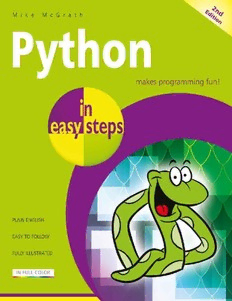Table Of ContentIn easy steps is an imprint of In Easy Steps Limited
16 Hamilton Terrace · Holly Walk · Leamington Spa
Warwickshire · United Kingdom · CV32 4LY
www.ineasysteps.com
Second Edition
Copyright © 2018 by In Easy Steps Limited. All rights reserved. No part of this book may be reproduced or
transmitted in any form or by any means, electronic or mechanical, including photocopying, recording,
or by any information storage or retrieval system, without prior written permission from the publisher.
Notice of Liability
Every effort has been made to ensure that this book contains accurate and current information. However, In
Easy Steps Limited and the author shall not be liable for any loss or damage suffered by readers as a result
of any information contained herein.
Trademarks
All trademarks are acknowledged as belonging to their respective companies.
Contents
1 Getting started
Introducing Python
Installing Python on Windows
Installing Python on Linux
Meeting the interpreter
Writing your first program
Employing variables
Obtaining user input
Correcting errors
Summary
2 Performing operations
Doing arithmetic
Assigning values
Comparing values
Assessing logic
Examining conditions
Setting precedence
Casting data types
Manipulating bits
Summary
3 Making statements
Writing lists
Manipulating lists
Restricting lists
Associating list elements
Branching with if
Looping while true
Looping over items
Breaking out of loops
Summary
4 Defining functions
Understanding scope
Supplying arguments
Returning values
Using callbacks
Adding placeholders
Producing generators
Handling exceptions
Debugging assertions
Summary
5 Importing modules
Storing functions
Owning function names
Interrogating the system
Performing mathematics
Calculating decimals
Telling the time
Running a timer
Matching patterns
Summary
6 Managing strings
Manipulating strings
Formatting strings
Modifying strings
Converting strings
Accessing files
Reading and writing files
Updating file strings
Pickling data
Summary
7 Programming objects
Encapsulating data
Creating instance objects
Addressing class attributes
Examining built-in attributes
Collecting garbage
Inheriting features
Overriding base methods
Harnessing polymorphism
Summary
8 Processing requests
Sending responses
Handling values
Submitting forms
Providing text areas
Checking boxes
Choosing radio buttons
Selecting options
Uploading files
Summary
9 Building interfaces
Launching a window
Responding to buttons
Displaying messages
Gathering entries
Listing options
Polling radio buttons
Checking boxes
Adding images
Summary
10 Developing applications
Generating random numbers
Planning the program
Designing the interface
Assigning static properties
Initializing dynamic properties
Adding runtime functionality
Testing the program
Installing a freezing tool
Freezing the program
Summary
Preface
The creation of this book has been for me, Mike McGrath, an exciting personal
journey in discovering how Python can be used today for procedural and object-
oriented programming, to develop applications and to provide online
functionality. Example code listed in this book describes how to produce Python
programs in easy steps – and the screenshots illustrate the actual results. I
sincerely hope you enjoy discovering the exciting possibilities of Python, and
have as much fun with it as I did in writing this book.
In order to clarify the code listed in the steps given in each example I have
adopted certain colorization conventions. Components of the Python
programming language are colored blue, programmer-specified names are red,
numeric and string data values are black, and comments are green, like this:
# Write the traditional greeting.
greeting = ‘Hello World!’
print( greeting )
Additionally, in order to identify each source code file described in the steps, a
colored icon and file name appears in the margin alongside the steps:
script.py
page.html
image.gif
For convenience I have placed source code files from the examples featured in
this book into a single ZIP archive. You can obtain the complete archive by
following these easy steps:
Browse to www.ineasysteps.com then navigate to Free Resources and
choose the Downloads section
Find Python in easy steps, 2nd edition in the list, then click on the
hyperlink entitled All Code Examples to download the archive
Next, extract the MyScripts and MyProjects folders to your home
directory (such as C:\ ) and copy all contents of the htdocs folder to your
web server’s documents directory
Now, follow the steps to call upon the Python interpreter and see the
output
You will also find updates, if any, to this book in the Downloads section for this
book.
1
Getting started
Welcome to the exciting world of the Python programming language. This chapter demonstrates how to
install Python and create your first program.
Introducing Python
Installing Python on Windows
Installing Python on Linux
Meeting the interpreter
Writing your first program
Employing variables
Obtaining user input
Correcting errors
Summary
Introducing Python
Python is a high-level (human-readable) programming language that is
processed by the Python “interpreter” to produce results. Python includes a
comprehensive standard library of tested code modules that can be easily
incorporated into your own programs.
The Python language was developed by Guido van Rossum in the late eighties
and early nineties at the National Research Institute for Mathematics and
Computer Science in the Netherlands. Python is derived from many other
languages, including C, C++, the Unix shell and other programming languages.
Today, Python is maintained by a core development team at the Institute,
although Guido van Rossum still holds a vital role in directing its progress.
Discover all the latest Python news online at www.python.org
The basic philosophy of the Python language is readability, which makes it
particularly well-suited for beginners in computer programming, and it can be
summarized by these principles:
• Beautiful is better than ugly.
• Explicit is better than implicit.
• Simple is better than complex.
• Complex is better than complicated.
• Readability counts.
As Python is intended to be highly readable, it uses English keywords frequently
where other languages may use punctuation. Most significantly, it uses

